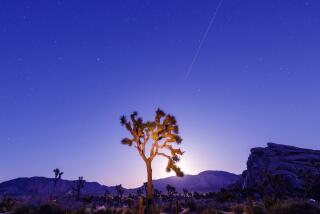Sunspots may quiet down for a while, scientists say
The next 11-year cycle of increased sunspot activity, scheduled to begin around 2020, may be delayed for a couple of years and have a reduced magnitude — or it may not occur at all, researchers said Tuesday.
Three different lines of evidence suggest that the sun, which is expected to reach its maximum sunspot and magnetic activity in the current cycle sometime in 2013, might even enter a prolonged quiet period similar to the so-called Maunder Minimum, a 70-year stretch from 1645 to 1715 in which virtually no sunspots were observed.
That minimum coincided with the “Little Ice Age,” in which temperatures were unusually low in Europe and elsewhere around the globe, and some researchers suggest that the two events were cause and effect — although direct evidence of that linkage is extremely limited.
“There is evidence that the sun goes into periods like that 10% to 15% of the time, and we may be due for another one,” said David H. Hathaway, a solar physicist at NASA’s Marshall Space Flight Center in Huntsville, Ala., who was not involved in the research. “They may be right,” he added, but he said more data should be collected before reaching such conclusions.
Other than potential effects on climate, a reduction in sunspots would have little direct impact on humans. Most of the terrestrial effects linked to sunspot activity — including interference with telecommunications, problems with power transmission, reduced lifetimes of satellites and other problems — occur when sunspot activity increases.
A minimum could even be a good time for space travel because there would be fewer magnetic storms that could harm humans who have escaped the Earth’s protective magnetic field.
Sunspots are caused by pockets of intense magnetic activity that disrupt the normal circulation of heated gases on the sun’s surface, leading to areas of cooling and reduced brightness.
Sunspot activity is linked to the solar cycle, in which the star’s magnetic poles are reversed every 22 years. As the magnetic fields shift around during these reversals, they create sunspots through mechanisms that are not yet entirely clear.
The findings, presented at a Las Cruces, N.M., meeting of the American Astronomical Society’s Solar Physics Division, represent the first wave of new data that should help physicists better understand the sun’s internal workings, said William Dean Pesnell, project scientist of the Solar Dynamics Observatory operated by the NASA Goddard Space Flight Center in Maryland.
“In the next five years, we should get to the point where we can run a large [computer] model that shows us where [solar] oscillations come from,” said Pesnell, who was not involved in the research.
Three separate studies reached the same conclusion on sunspots.
Frank Hill of the National Solar Observatory at Sacramento Peak in New Mexico and his colleagues studied streams of fields flowing under the sun’s surface, the solar equivalent to the Earth’s jet stream. Using a process known as helioseismography, which monitors sound waves emitted by these solar jet streams, they found that jet streams that precede the normal beginning of a solar cycle are missing. This suggests that the next sunspot cycle should be weak at best.
Their observations accurately predicted the late beginning of the current sunspot cycle.
Matt Penn of the National Solar Observatory and his colleagues used the McMath-Pierce Telescope at Kitt Peak in Arizona to monitor the magnetic strength of sunspots. They observed that for the last 13 years, the strength has been declining regularly. Doing what Penn called “the dangerous activity of extrapolating to the future,” the team predicted that continued decreases would lead to a point where magnetic fields would not be sufficiently intense to create sunspots.
And finally, Richard Altrock, manager of the Air Force’s coronal research program at Sunspot, N.M., used four decades of measurement of the sun’s corona — the “atmosphere” of ionized atoms above the sun’s surface — to show that magnetic activity at the sun’s poles had been declining. Such declines are linked to decreased sunspot activity.
“The fact that there are three separate lines of evidence all pointing in the same direction is very compelling,” Hill said. But, he added, researchers have no way of predicting how long a period like the Maunder Minimum might last, if it does occur.
As for the potential effects on climate, “there is not enough evidence either way,” he said. But, he added, if the next cycle doesn’t occur, “it will be a good opportunity to find out.”
More to Read
Start your day right
Sign up for Essential California for news, features and recommendations from the L.A. Times and beyond in your inbox six days a week.
You may occasionally receive promotional content from the Los Angeles Times.






